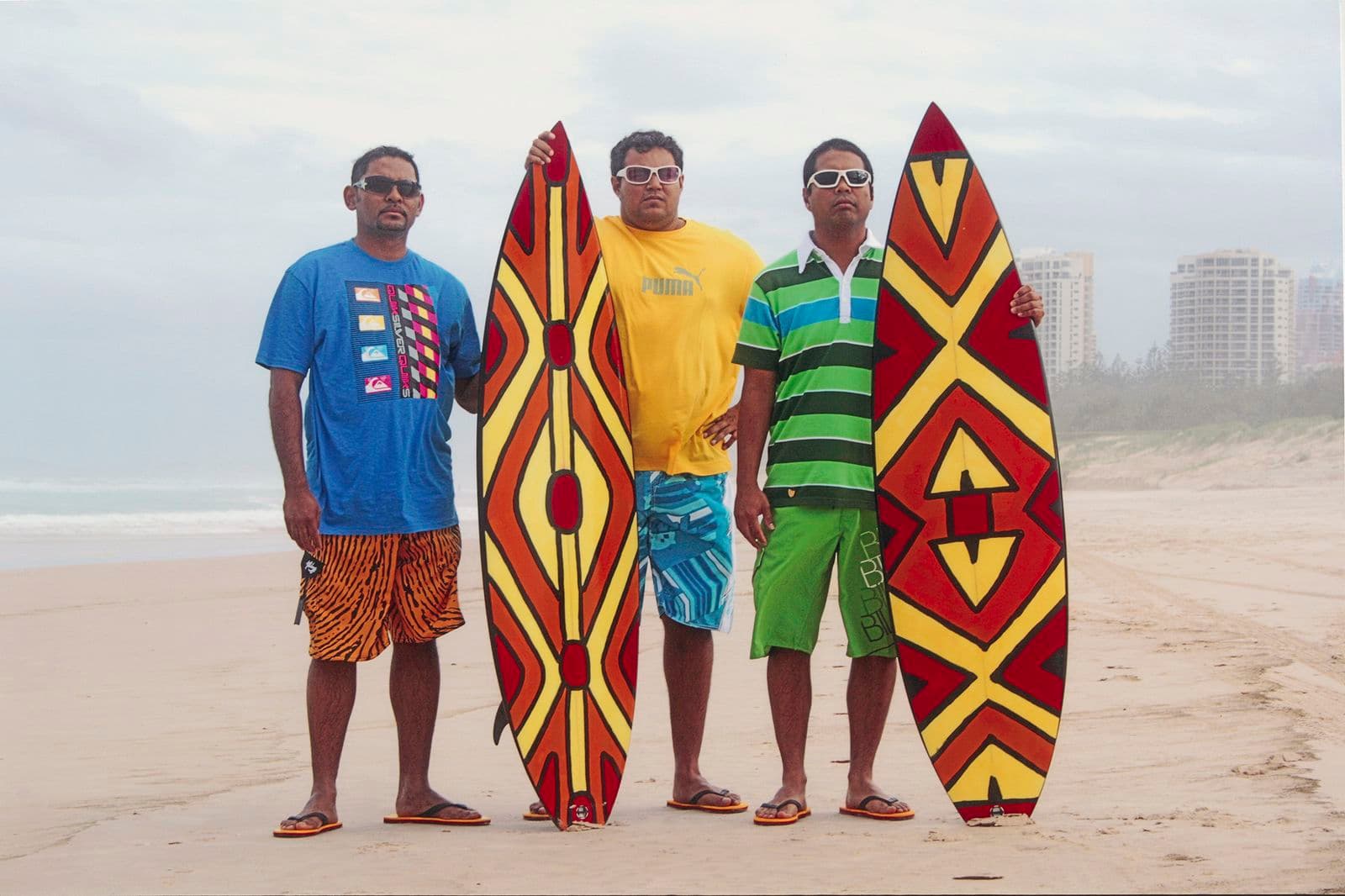Responding

Vernon Ah Kee, Kuku Yalanji/Yidinji/Waanyi/Gugu Yimithirr/Koko Berrin peoples, Can't chant (wegrewhere) #2, 2009, purchased 2009. © Vernon Ah Kee.
Damien Shen and Richard Lyons Ventral aspect of two males
Damien Shen is a South Australian man of Ngarrindjeri and Chinese descent. In his photographic series On the Fabric of the Ngarrindjeri Body: Volume III, a collaboration with photographer Richard Lyons, Shen gained knowledge of traditional Ngarrindjeri body designs from his uncle, Ngarrindjeri Elder Uncle Moogy (Major Summer), shown in this images.
The body painting shown had not been practiced for several generations, and Shen describes feeling 'empowered through this process of learning and spending time with my Elder'.
Shen’s practice demonstrates the way that photography can be drawn upon to capture important cultural knowledge, but also emphasises the importance of the passing down of practices from generation to generation. Likewise, Ricky Maynard utililises the medium of photography to make an intimate record of the traditional mutton birding harvest on several islands in Tasmania.

Damien Shen, Ngarrindjeri people, and Richard Lyons Ventral aspect of two males 2014, purchased 2016.
Responding activity
Primary students:
Think about the purpose of a family photo album. What memories do they hold? What do the photographs show about the people and places represented? Do the people in the photos look happy to be photographed? Are they posing or are they unaware the photo has been taken?
As a class use a digital camera to document an activity that you do together. Nominate some class members as photographers and others as subjects. Think about how you might work together—how should you communicate? What sorts of things you can do to ensure that you are working together respectfully? As the photographer, what do you want this to record for the future?
Senior students:
Historically, photography has not always been used to capture Indigenous peoples and cultures in a positive light. At times it has been used in the fields of Anthropology and Ethnography to classify Indigenous peoples, taking away their individuality and agency. Contemporary artists working in photomedia practices therefore have an opportunity to reclaim the medium and correct this imbalance of power.
Construct an argument in response to the following statement:
The photographer holds the ultimate power to represent, to make visible or invisible, to record truth or distort reality.
To what extent do you agree?
Useful links
Warwick Thornton's Way of the Ngangkari
Warwick Thornton is a Kaytej man whose customary lands reside in the north of Alice Springs where he has lived most of his life. Thornton is an acclaimed filmmaker and visual artist who has directed award-winning films including Sampson and Delilah (2009), Green Bush (2005) and Sweet Country (2017).
This work of art draws upon a formative experience Thornton had as a child seeing the Star Wars films and being captivated by the fantasy of the Jedi. He recalls having the realisation that he also has Jedi in his family except that they are called 'Ngangkari', and are 'men and women with special powers that can be used for good or evil. The power to heal or the power to kill.'
In this series of video works Warwick Thornton has inserted Indigenous figures into a popular culture narrative. Similarly, Brian Robinson in his linocut As the rains fell and the seas rose (2010) re-writes the biblical story of Noah’s Ark, inserting pop culture characters as well as Torres Strait Islander warriors into the tale.

Installation view of Warwick Thornton Way of the Ngangkari #2, #3 and #6 2015, purchased 2016. Courtesy of the artist and Anna Schwartz Gallery
Responding activity
Consider the popular culture narratives that resonate with you—these might be from sci-fi, popular films, TV shows or comic books—and how you might re-write these. Consider the context of the original text compared with your own. What parallels might you find? How could these texts be subverted or re-written to carry a new meaning?
Useful links
Wawilak Sisters by Dundiwuy Wanambi, Wolpa Wanambi and Motu Yunupingu
Dundiwuy Wanambi (Marrakulu people), Wolpa Wanambi (Marrakulu people) and Motu Yunupingu (Gumatj people) created this sculpture of a group of Indigenous ancestral figures in Gurka’wuy in North East Arnhem Land in the Northern Territory.
The (Wawilak) Wagalak sisters carry power in their dilly bags and use it to create the landscape as they walk across Marrakulu country on the east coast of Arnhem Land. Their spirit name is Djangka-Bu. The younger sister’s lover, Wuyal, is seen carrying Dhulaku, the rock wallaby on his head, while lengths of feathered string hanging from the older sister’s arms represent the trails they travelled.
Wuyal and the Wagalak sisters’ bodies are ‘painted up’ with Marrakulu miny’tji (clan designs) or sacred patterns featuring sections containing two boomerangs, face to face. With these boomerangs Wuyal named all the places in Marrakulu country. The ancestors’ faces are adorned with a dotted design, representing drops of honey that signify the spiritual life forces upon which the Marrakulu people depend.

Dundiwuy Wanambi, Wolpa Wanambi and Motu Yunupingu Wawilak Sisters 1995–1996, purchased 1996 © Dundiwuy Wanambi courtesy Buku-Larrnggay Mulka
Responding activity
Spend a moment quietly looking at Dundiwuy Wanambi’s sculpture Wawilak Sisters. Sitting in a circle take turns to share an observation starting with the phrase “I see…”. Affirm the observation shared by the person before you and add your own observation by saying “(person’s name) sees… and I see…” Discuss the feelings, narratives or questions that your observations evoke.
Watch Dust Echoes: The Wagalak Sisters animation and discuss how the story changes the way you see the work of art. What do you think we could learn from the story?

